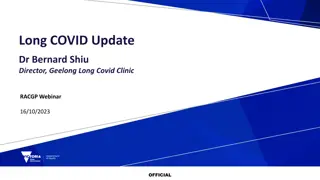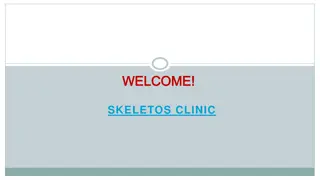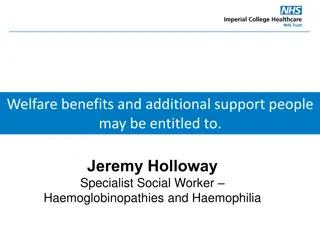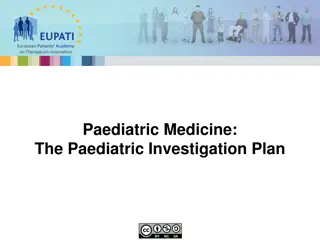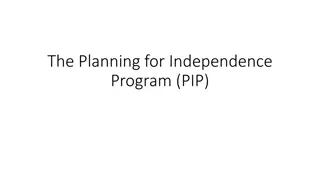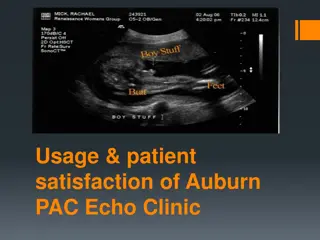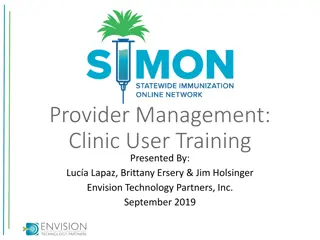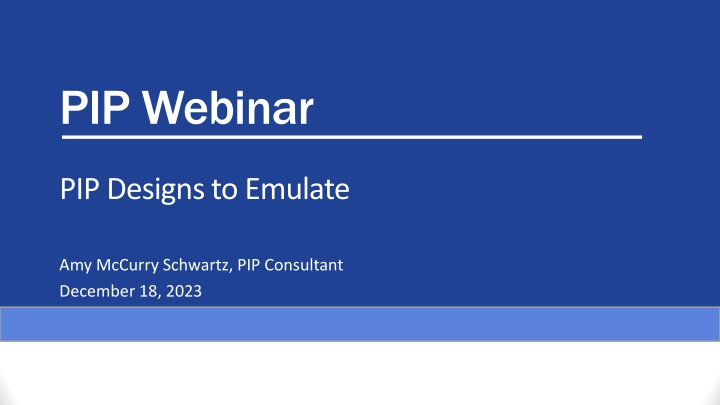
Effective PIP Strategies: Learn from Industry Experts
Join the upcoming webinar to explore successful PIP designs, understand the purpose of PIPs, types of PIPs, and upcoming clinic topics. Discover how to identify PIP topics, develop aim statements, implement improvement strategies, analyze data, and interpret results for significant and sustained improvements.
Download Presentation

Please find below an Image/Link to download the presentation.
The content on the website is provided AS IS for your information and personal use only. It may not be sold, licensed, or shared on other websites without obtaining consent from the author. If you encounter any issues during the download, it is possible that the publisher has removed the file from their server.
You are allowed to download the files provided on this website for personal or commercial use, subject to the condition that they are used lawfully. All files are the property of their respective owners.
The content on the website is provided AS IS for your information and personal use only. It may not be sold, licensed, or shared on other websites without obtaining consent from the author.
E N D
Presentation Transcript
PIP Webinar PIP Designs to Emulate Amy McCurry Schwartz, PIP Consultant December 18, 2023
Purpose of Todays Webinar Review examples of successful PIPs Identifying the Problem Aim Statement Interventions Results
What is a PIP? CMS: A PIP is a project conducted by the BHP that is designed to achieve significant improvement, sustained over time, in health outcomes and enrollee satisfaction. A PIP may be designed to change behavior at a member, provider, and/or BHP/system level. Source: CMS External Quality Review (EQR) Protocols, October 2019, Protocol 1. Validation of Performance Improvement Projects, p. 27. DHCS requires that two active PIPs are in place during the preceding 12 months of a review.
Types of PIPs Non-clinical Clinical There is not an intervention that relates to the direct treatment of beneficiaries Reminder calls; texts; emails; newsletters; new scheduling system . At least one intervention relates to the direct treatment of beneficiaries At least one indicator that measures (or is a proxy for) a clinical outcome or impact Requires at least one beneficiary- level indicator There must be meaningful association with outcomes or improved care for beneficiaries
March 2023 PIP Clinic Topics Implementing interventions for BHQIP PIP based on Root Cause Analysis Developing Data Collection and Implementation plans Measuring the effectiveness of Interventions # of patients referred from ED to BHP # of referred patients who complete follow up appointment
June 2023 PIP Clinic Topics Intervention Review Collaboration and Barrier analysis involving the ED (FUM/FUA) Capacity to respond to referrals (FUM) Single point of contact for EDs (FUM) Further analysis for pinpoint intervention identification (FUM) Ensuring linkage to Data Exchange
September 2023 PIP Clinic Topics Template Updates Specific Examples of Changes made by BHPs in response to the update Review of FUA and POD PIPs Review of non-BHQIP PIP
PIP Designs to Emulate December 2023 Plan for this webinar Identify the PIP Topic Developing an Aim Statement Improvement Strategy & Implementation Plan Data Analysis & Interpretation of PIP Results Likelihood of Significant & Sustained Improvement Example A In Home Based Services Example B Follow Up After Hospitalization
Step 1: Identify the PIP Topic What is the Problem? Improvement in clinical service or non-clinical process Directly impacts high-volume or high-risk beneficiaries Potential to significantly impact health, functional status, or satisfaction Behavioral Health Concepts, Inc.
Step 1: Identify the PIP Topic Example A Medi-Cal claims data show that BHP County children and youth beneficiaries are less likely than their peers in other medium and large counties to receive IHBS services. Fewer County eligibles receive IHBS: The most recent 2020 Approved Claims Report disclosed that on average, BHP provided IHBS services to 288 children per month. This represented 0.10% of Medi-Cal eligibles, which was equal to the proportion of Medi-Cal eligibles served by medium-sized MHPs, but less than 0.15% of eligibles served by MHPs statewide. The Claims Report also shows that only 28% of ICC beneficiaries received IHBS services in 2020. While the claims report did not provide statewide statistics, typically, a large proportion of ICC beneficiaries across the state receive IHBS. One county reported 63% of its ICC participants receiving IHBS. Fewer approved claims per beneficiary: On average, each BHP beneficiary who received IHBS services in 2020 generated $2,362 in approved claims per year. This was 54% less than the $5,167 in approved claims for medium county beneficiaries and 56% less than the $5,316 in approved claims per statewide beneficiary. Behavioral Health Concepts, Inc.
Step 1: Identify the PIP Topic Example A Medi-Cal claims data show that BHP County children and youth beneficiaries are less likely than their peers in other medium and large counties to receive IHBS services. Greater need in BHP County: Compared to state averages, BHP County provides less IHBS service to fewer Medi-Cal eligibles, but the need for services is equal or greater. The 2020 Approved Claims data report shows that 0.35% of County Medi-Cal eligibles receive Intensive Care Coordination (ICC) services, versus 0.22% for medium counties and 0.25% statewide. County has a higher proportion of children/youth who are at-risk of out-of-home placement by many standards, including higher rates in in foster care (6.5 per 1000 vs 5.3 statewide), higher school suspensions (43.4 per 1000 vs 24.5 statewide) and lower feelings of school connectedness (34.9% versus 44.8%). Twenty-one percent (21%) of area children have experienced two or more ACES versus 15% statewide. The area has the highest rates of serious emotional disturbance (SED) per region (8.1% versus 7.6% statewide) Behavioral Health Concepts, Inc.
Step 1: Identifying the PIP Topic Example A Medi-Cal claims data show that BHP County children and youth beneficiaries are less likely than their peers in other medium and large counties to receive IHBS services. Barriers In non-foster programs, if families qualify for IHBS, they need to transfer to a new program with a new ICC therapist. Children and caregivers are sometimes reluctant to transfer, and clinicians may be reluctant to encourage IHBS because transferring does not promote continuity of care Clinicians who are assigned to ICC teams are more comfortable providing therapy and thus prioritize therapy over IHBS service provision. The adult system of care does not have sufficient capacity, and staff do not have the specialized training, to provide IHBS to 18 to 20-year-olds within their service delivery system Staff do not recognize that IHBS services are considered intensive and in fact, don t recognize the frequency with which IHBS services should be delivered. Staff in non-foster care programs do not understand what IHBS is, how it differs from other services, and why it is meaningful, and as a result, don t know how to promote it among children and caregivers. Behavioral Health Concepts, Inc.
Step 1: Identifying the PIP Topic Example A Medi-Cal claims data show that BHP County children and youth beneficiaries are less likely than their peers in other medium and large counties to receive IHBS services. Barriers There is a lack of training in IHBS requirements or fidelity expectations There is no mechanism for ensuring staff are screening for IHBS eligibility when they are supposed to be screening (i.e., no electronic reminders or triggers when a qualifying event, such as hospitalization, establishing multiple diagnoses, or prescribing multiple medications). There are referral delays once children and caregivers agree to IHBS Behavioral Health Concepts, Inc.
Step 2: Develop the Aim Statement What do we want to do? Include: The focus of the PIP The plan for improvement Description of who is being helped Goal Time frame Behavioral Health Concepts, Inc.
Step 2: Developing the Aim Statement Example A By the March 2023, can BHP s Children and Youth Services increase the number of Medi-Cal eligibles who receive IHBS services and the number of IHBS services provided per beneficiary by 20% over the FY 21/22 baseline period by: (1) restructuring programs to prioritize IHBS services and support continuity of care; (2) cultivating more effective family engagement practices to encourage participation; and (3) automating screening and referral process to ensure children/youth do not fall through the cracks? PIP Focus: Access to Care Population Medi-Cal beneficiaries, children/youth Improvement Strategy Goal Restructuring programs to prioritize IHBS services and support continuity of care Children s Mobile Assessment Team 20 percentage point increase Time frame Cultivating more effective family engagement practices 18-month period Automating screening and referral process Behavioral Health Concepts, Inc.
Step 6: Improvement Strategy & Implementation Plan What will we do to cause change? Describe the improvement strategy/strategies Translation: Intervention Why were they selected? Evidence-based? Address cultural and linguistic needs? How will they be implemented? Who will apply the interventions? How does the MHP/DMC-ODS verify the interventions are applied as intended? Behavioral Health Concepts, Inc.
Step 6: Improvement Strategy & Implementation Plan Example A What are the interventions? Restructure outpatient programs to support continuity of care and promote IHBS specialization Cultivate more effective family engagement practices Automating screening and referral process Why were they selected? Barrier analysis Evidence Based/Data review Behavioral Health Concepts, Inc.
Step 6: Improvement Strategy & Implementation Plan Example A How will they be implemented? Restructure outpatient programs to support continuity of care and promote IHBS specialization. The PIP will allow non-dependent children/youth who meet medical necessity for ICC and IHBS to remain with their core services clinician and receive adjunctive IHBS from trained IHBS specialists and outreach workers. This will ensure that the continuity of care by the clinician is maintained and IHBS are provided by a specialized and dedicated adjunctive team. Cultivate more effective family engagement practices Trained staff will explain to family members the relevance and distinction between IHBS and other service modalities, the frequency with which it will be provided, and provide examples of how services are delivered in the field. Clinicians will explore motivations and barriers to services and potential strategies for overcoming barriers, and if children/youth and/or caregivers decline services they will be encouraged to reach out if they change their minds. Automating screening and referral process An IHBS Screening Form will automatically appear ( auto-populate ) in to-do list when an IHBS criterion is met, requiring clinical coordinator to assess for eligibility and complete the form within two business days. Behavioral Health Concepts, Inc.
Step 6: Improvement Strategy & Implementation Plan Example A How will they be implemented? Number and percentage of IHBS screenings competed within 30 days of admission Number and percentage of IHBS screenings completed within a month of the clients six-month anniversaries Number and percentage of IHBS screenings completed within 7 days of hospitalization Number and percentage of those who met criteria who accepted IHBS Number and percentage who declined IHBS and distribution of reasons for declining Number and percentage who received IHBS within 15 days of acceptance Number and percentage who received at least two IHBS services in the month Number and percentage who received at least three IHBS services in the month Average number of IHBS received within 6 months of admission Behavioral Health Concepts, Inc.
Step 8: Data Analysis & Interpretation of PIP Results What do the data tell us, and what did we learn? Implementation Analysis Was the PIP implemented as planned? Outcome Analysis Did we achieve our performance objectives? How was change/improvement assessed? To what extent was the data analysis plan followed? Did any factors threaten the validity of the results? Behavioral Health Concepts, Inc.
Step 8: Data Analysis & Interpretation of PIP Results Example A Was the PIP Implemented as planned? Strategy #1:Restructure programs to support continuity of care and promote IHBS specialization: Number of FTE staff dedicated to providing IHBS in the new adjunctive IHBS program for nondependent (non-foster) youth: CYS initially allocated 5 positions dedicated to providing IHBS in the new adjunctive nondependent IHBS program. While staffing levels fluctuated throughout the implementation phase, by February 2023, there were 6 dedicated providers: one chief mental health clinician; three mental health specialists; and two outreach workers. Number of non-foster care children/youth served in the new adjunctive IHBS program:The adjunctive IHBS program launched in July and increased census over a four-month period until stabilizing to between 50 and 57 clients served per month. In the year prior to the launch of the PIP (FY21-22) only 49 non-dependent children/youth received IHBS at any point during the year. By comparison, in just one month alone (January 2023), 57 such youth received IHBS. Number of 18 to 20-year-olds receiving IHBS services,measured each month following CYS s decision to serve foster youth until age 21: Once CYS began serving foster youth until the age of 21 (rather than transitioning them to the adult system of care at age 18) the total number of youths receiving IHBS services increased significantly. In January 2023, for example, the MHP provided IHBS to nine 18 to 20-year-olds versus only one in the previous year. Behavioral Health Concepts, Inc.
Step 8: Data Analysis & Interpretation of PIP Results Example A Was the PIP Implemented as planned? Strategy #2: Cultivate more effective family engagement practices: Documented the number and percentage of eligible families who were encouraged and agreed to participate in IHBS: The PIP involved greater emphasis on family engagement practices, driven by increased staff training, supervision, documentation of motivational practices, and identification of strategies for overcoming barriers and the reasons for declining service. Since project launch, the number of documented families who were encouraged to participate in IHBS increased from one (1) to 110 over a 5-month period and then declined to approximately 70 per month. The number who then agreed to participate ranged from 50-67 families per month, which translated to between 60-88% of IHBS eligible families. Behavioral Health Concepts, Inc.
Step 8: Data Analysis & Interpretation of PIP Results Example A Was the PIP Implemented as planned? Number of automated screening reminders sent to clinical coordinators inbox following a qualifying event: Initially, the intent of the project was toestablish automated alerts of clients meeting criteria for IHBS based on the documentation of qualifying events, such as two or more hospitalizations within 12 months or the prescribing of two or more concurrent antipsychotic medications. However, programming the alert system proved overly complex, and in-lieu, the project implemented a simpler system to alert counselors of clients 6-month treatment anniversaries. The alert sends a screening form to the counselors inbox as a reminder to engage and screen unserved families. The 6-month alert system launched in January 2023; by February, the system alerted counselors of 84 6-month anniversaries for individuals not already receiving ICC/IHBS services. The number of alerts each month, between February and May 2023, ranged from approximately 70-100, providing a significant opportunity and expectation to rescreen and reengage children/youth and their caregivers. Number of referrals routed to supervisor: Upon completion of the screening form, if a family agrees to services, the form is automatically routed to a supervisorto ensure that IHBS providers are assigned and clients are offered appointments in a timely manner. Client-level data are displayed in a newly developed ICC/IHBS program monitoring application to ensure that no family that wants/needs IHBS falls through the cracks. Generally, for families who agree to IHBS, between 42-56% receive their initial service within 15 days. The relatively low rates can be attributed to one of the following reasons: 1) families not responding to attempts to reach them; 2) families declining first offered appointments; 3) staff not following up immediately when cases are assigned to them; or 4) client no-show or cancellation. Low rates suggest area opportunities for greater investigation and potential improvement. Behavioral Health Concepts, Inc.
Step 8: Data Analysis & Interpretation of PIP Results Example A Outcome #1: Number of children/youths receiving IHBS services: Between the FY 21-22 and March-May 2023, the average number of children/youths who received IHBS services increased from 130 to 263, a 102% increase, which was well over the goal of 20% improvement that the PIP Workgroup had established. Outcome #2: Number of services received monthly per child/youth receiving IHBS services Between FY21-22 and March-May 2023, the average number of IHBS services delivered increased from 290 to 572, a 97% increase. The number of IHBS services per child/youth remained nearly the same between the two periods, 2.23 per month in FY21/22 and 2.17 per month in March-May 2023. Behavioral Health Concepts, Inc.
Step 8: Data Analysis & Interpretation of PIP Results Example A Statistically significant change in performance (Yes/No) Specify P-value Most recent Remeasure sample size and rate Demonstrated performance improvement (Yes/No) Initial measureme nt Dates/Years Initial sample size and rate Baseline Dates/Year Performance Measure Description Target Performance Rate Most recent Remeasure Dates/Year Baseline Measurement Yes No 20% Fiscal Year 2021-22 Average of 130 children/youth served monthly Oct-Dec 2022 Average of 200 children/you th served monthly March May 2023 Average of 263 children/youth served monthly N/A improvement Average number of children/youth receiving IHBS services monthly 102%increase over baseline Yes No 8.2% of CYS population Oct-Dec 2022 10.7% of CYS population March May 2023 14.1% of CYS population Statistically significant increase at p<.05. P-value is <0.00001 n/a FY 2021-22 Percentage of CYS child/youth population Yes No 20% Fiscal Year 2021-22 Average of 2.23 services/client each month Oct-Dec 2022 Average of 1.91 services/clie nt each month March May 2023 Average of 2.17 services/client each month N/A Average number of services received monthly per child/youth receiving IHBS services improvement 2.7% decrease from baseline -- Behavioral Health Concepts, Inc.
Step 9: Likelihood of Significant and Sustained Improvement Through the PIP Did we make a difference, and will it have an ongoing impact? Non-dependent children/youthremain with their core therapist and receiveadjunctive IHBS from a dedicated provider rather than transition to a new care team. In the single month, March 2023, 52 non- foster children/youth received adjunctive IHBS services, which was more than the 49 children/youth who had received IHBS in the entire FY21-22. By serving foster youth until age 21, the number of foster youths receiving IHBS increased dramatically. Between January - March 2022, on average, only one (1.3) 18-20-year-old received IHBS; one year later (Jan Mar 2023) the average number served each month within this age range increased to six (6.3). Training, supervision, and emphasis on family engagement and motivational practices meant that during the intervention period between 60-88% of eligible families agreed to IHBS services. Behavioral Health Concepts, Inc.
Step 9: Likelihood of Significant and Sustained Improvement Through the PIP Did we make a difference, and will it have an ongoing impact? While establishing an automated alert system for all qualifying events proved onerous, CYS was able to produce a simpler 6-month anniversary alert. Each month on average, between March May 2023, counselors received alerts for 87 unserved children/youth at their 6-month treatment anniversaries, providing additional opportunities to screen, engage, and encourage IHBS participation. An automated system for transmitting and tracking referrals ensures immediate transfer of referrals to the counselors supervisors for approval and helps to ensure that eligible families who wish to participate in IHBS services are assigned a counselor and offered treatment in a timely manner. Nonetheless, between January and March 2023, only 48% of eligible families who want services receive services within 15 days. The figures suggest that there is still some room for increasing timely access. Behavioral Health Concepts, Inc.
Step 1: Identify the PIP Topic What is the Problem? Improvement in clinical service or non-clinical process Directly impacts high-volume or high-risk beneficiaries Potential to significantly impact health, functional status, or satisfaction Behavioral Health Concepts, Inc.
Step 1: Identify the PIP Topic Example B The concept for this PIP emerged in July 2021 from an analysis of post-hospitalization service delivery data. The BHP reviewed six months of billing records of all 383 patients discharged from hospitals between January 1 June 16, 2021, and found that only 33% had attended a follow-up visit with a mental health provider within 7 days of discharge. The BHP discovered that adult discharges were significantly less likely to receive timely aftercare than children, and that discharges from out-of-county hospitals and from the county-run PHF had similar follow-up rates. Patients who had received outpatient services in the previous 3 months were significantly more likely to have gotten follow-up care than those who had not. The National Committee for Quality Assurance (NCQA) established standardized Healthcare Effectiveness Data and Information Set (HEDIS) measures for the Centers for Medicare & Medicaid Services (CMS) to enable MHPs to compare performance between programs and systems of care. One HEDIS measure is percentage of inpatient discharges, among individuals 6 years and older, that resulted in follow-up care with a MH provider within 7 days. According to NCQA, timely follow-up care can substantially improve outcomes and reduce rehospitalizations. In 2019, 36.2% of Medicaid HMOs and 46.2% of commercial HMOs provided follow-up care within 7 days of discharge. Behavioral Health Concepts, Inc.
Step 1: Identifying the PIP Topic Example B The BHP reviewed six months of billing records of all 383 patients discharged from hospitals between January 1 June 16, 2021, and found that only 33% had attended a follow-up visit with a mental health provider within 7 days of discharge Barriers Some beneficiaries, including the previously unserved and those who were resistant to services, need additional support and opportunity to attend appointments. Forty-one percent (41%) of discharged clients cancelled or no-showed to aftercare appointments that were scheduled within the 7-day window. Staff reported that many community members lack literacy about how to access the county mental health system of care; they may be overwhelmed upon discharge or feel that follow-up is unnecessary or burdensome. Some beneficiaries face multiple barriers to follow-up treatment including lack of transportation and geographical isolation, chaotic homelives, physical and mental disabilities, and conflicting work or school schedules. Outpatient case managers serving homeless clients describe difficulties locating and identifying their clients in encampments. Other clients are especially resistant to treatment and need more than logistical support to encourage follow-through. Long waits for post-hospitalization follow-up appointments. During the two-year baseline period (FY 19- 20 & FY 20-21), of the 1,222 adult discharges, only 41% (495) were offered a follow-up appointment of any type within 7 days. For those who were offered a timely appointment, more than half (59%) attended the appointment within the 7-day timeframe, suggesting that shorter wait times will help solve the problem. Gaps in communication between hospitals and outpatient programs. Outpatient case managers report that they don t always know when their clients are in the hospital, particularly if the clients are hospitalized out of county. Clients sometimes discharge without notice or on weekends, making it difficult for the ASOC outpatient support team to immediately follow up. Behavioral Health Concepts, Inc.
Step 2: Develop the Aim Statement What do we want to do? Include: The focus of the PIP The plan for improvement Description of who is being helped Goal Time frame Behavioral Health Concepts, Inc.
Step 2: Developing the Aim Statement Example B By improving communications between hospitals and the outpatient system of care and establishing a twice-weekly post-hospitalization outpatient clinic, BHRS will increase the percentage of adult beneficiaries who receive follow-up care within 7 days of psychiatric hospital discharge from a FY 20-21 baseline of 36% to a national standard of 46% and significantly increase the percentage who have 7-day medication management follow-ups, in particular by FY22-23. Population PIP Focus: Medi-Cal beneficiaries, adult Quality of Care Goal Improvement Strategy 10 percentage point increase Improved communications and coordination of care between hospitals and the adult outpatient system of care (ASOC) Time frame 24-month period Semi-Weekly Post-Hospitalization Clinic Behavioral Health Concepts, Inc.
Step 6: Improvement Strategy & Implementation Plan What will we do to cause change? Describe the improvement strategy/strategies Translation: Intervention Why were they selected? Evidence-based? Address cultural and linguistic needs? How will they be implemented? Who will apply the interventions? How does the MHP/DMC-ODS verify the interventions are applied as intended? Behavioral Health Concepts, Inc.
Step 6: Improvement Strategy & Implementation Plan Example B What are the interventions? Improved communications and coordination of care between hospitals and the adult outpatient system of care (ASOC) Semi-Weekly Post-Hospitalization Clinic Why were they selected? Barrier analysis Evidence Based/Data review Behavioral Health Concepts, Inc.
Step 6: Improvement Strategy & Implementation Plan Example B How will they be implemented? Upon hospital admission, social worker will email outpatient support team members so that they can coordinate care and discharge planning Upon out-of-county hospital admission, BHRS s 24-hour triage team will email the outpatient support team. In-lieu of scheduled appointments, BHP will offer a post-hospitalization outpatient clinic two times per week. Behavioral Health Concepts, Inc.
Step 6: Improvement Strategy & Implementation Plan Example A How will they be implemented? Number of email notifications Number of email notifications from triage Number of clients served at post-hospital clinic Behavioral Health Concepts, Inc.
Step 8: Data Analysis & Interpretation of PIP Results What do the data tell us, and what did we learn? Implementation Analysis Was the PIP implemented as planned? Outcome Analysis Did we achieve our performance objectives? How was change/improvement assessed? To what extent was the data analysis plan followed? Did any factors threaten the validity of the results? Behavioral Health Concepts, Inc.
Step 8: Data Analysis & Interpretation of PIP Results Example A Was the PIP Implemented as planned? Number and percentage of admission and discharge email notifications from MGPC social workers to ASOC upon hospital admission. As part of the PIP, social workers emailed admission and discharge notifications to outpatient care teams. Triage staff also began cc ing care teams prior to out-of-county hospital transports; however, this intervention broke down almost as soon as it began, when the responsibility for transportation shifted from BHP to the Managed Care Plan. To track email notifications, social workers were instructed to use standardized email subject headings and copy the ASOC analyst. After several months, the PIP Committee recognized that the large email distribution lists and frequent notifications contributed to disregard of the admission and discharge notifications, so social workers were encouraged to email just staff with the most recent progress notes. In general, email notification has been inconsistent and difficult to track. Behavioral Health Concepts, Inc.
Step 8: Data Analysis & Interpretation of PIP Results Example B Was the PIP Implemented as planned? Number and percentage of clients served at Post-Hospitalization Clinic The ASOC launched the twice-weekly Post-Hospitalization Clinic July 2022. Social workers inform patients of their clinic day during the discharge process. For out of county hospitalizations, discharge instructions are attached to patients admission packets with directions for social workers to transmit discharge paperwork and inform patients of their clinic date. One day a week is reserved for beneficiaries already open to outpatient services; the other day provides extended hours to ensure beneficiaries who are not yet opened to outpatient services have time to complete admission process. All beneficiaries receive a brief needs assessment designed to identify barriers to immediate stabilization and receive both psychiatric and non-psychiatric bridge supports to help prevent rehospitalization and linkage to planned services Behavioral Health Concepts, Inc.
Step 8: Data Analysis & Interpretation of PIP Results Example B Outcome #1: Percentage who received follow-up care within 7 days of hospital discharge. Outcome goal: Increase rate of post-hosp. 7-day follow-up from 36% to > 46%. The data show that there were statistically significant improvements in follow-up rates between baseline and year-two, overall for all hospitals and all beneficiaries. There was significant improvement among beneficiaries who were previously unopened to mental health services. Follow- up rates among those hospitalized in county, hospitalized out of county, and previously opened to services also experienced improvements, albeit not achieving statistical significance at p<.05. Outcome #2: Percentage who received medication management within 7 days of hospital discharge. Outcome goal: Significantly increase the rate of 7-day post-hosp. medication management BHP found improvements in the first year and then statistically significant improvement rates in the second remeasurement period overall, within county hospital, and out-of-county hospitals, and among unserved as well beneficiaries already open to services. Behavioral Health Concepts, Inc.
Step 8: Data Analysis & Interpretation of PIP Results Example B Most recent remeasurement sample size and rate Demonstrated performance improvement (Yes/No) Most recent remeasurement year Statistically significant change in performance (Yes/No) PMs (be specific and indicate measure steward and National Quality Forum number if applicable): Baseline sample size and rate Baseline year (if applicable) Specify P-value (if applicable) Yes Yes No 7-Day Post Hospitalization Follow-Up Rate (any Medi-Cal billable service) FY 22-23 329/712 = 46.2% FY 20-21 245/672 = 36.5% 1. No P-value: 0.0002 <.01 <.05 Other (specify): Significance tested using chi-sq two by two test comparing baseline and most recent measurement period. Yes Yes No 7-Day Post Hospitalization Follow-Up Rate (Medication Management services) FY 22-23 FY 20-21 68/678 = 10.1% 195/712=27.4% 1. No P value: <0.00001 <.01 <.05 Other (specify): Significance tested using chi-sq two by two test comparing baseline and most recent measurement period Behavioral Health Concepts, Inc.
Step 9: Likelihood of Significant and Sustained Improvement Through the PIP Did we make a difference, and will it have an ongoing impact? The MHP significantly increased the proportion of adult Medi-Cal beneficiaries who receive 7-day follow- up care from 36.5% to 46.2%, meeting the national benchmark of 46%. Improvements were achieved in all sub-categories, statistically, among beneficiaries unenrolled in outpatient treatment. Moreover, the proportion of beneficiaries who received medication management within 7 days of psychiatric hospitalization discharge significantly improved across all sub-categories, and overall from 10.1% to 27.4% The changes appear to be driven by changes within the Adult System of Care, most notably the establishment of a specialized, multidisciplinary clinic serve as a bridge between psychiatric hospitalization and ongoing, routine treatment. The PIP had the greatest effect on patients who were unserved by outpatient programs prior to their hospitalization. This is presumably because the Post-Hospitalization Clinic dedicated one day each week to serving this constituency. Behavioral Health Concepts, Inc.
Contact Information Amy McCurry Schwartz, Esq., MHSA amy.mccurry@bhceqro.com (855) 385-3776 x 103 *PIP Technical Assistance is available from your assigned Quality Reviewer www.caleqro.com




